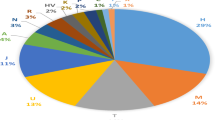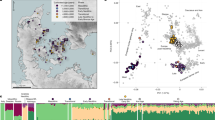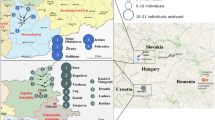Abstract
As a result of the combination of great linguistic and cultural diversity, the highland populations of Daghestan present an excellent opportunity to test the hypothesis of language–gene coevolution at a fine geographic scale. However, previous genetic studies generally have been restricted to uniparental markers and have not included many of the key populations of the region. To improve our understanding of the genetic structure of Daghestani populations and to investigate possible correlations between genetic and linguistic variation, we analyzed ~550 000 autosomal single nucleotide polymorphisms, phylogenetically informative Y chromosome markers and mtDNA haplotypes in 21 ethnic Daghestani groups. We found high levels of population structure in Daghestan consistent with the hypothesis of long-term isolation among populations of the highland Caucasus. Highland Daghestani populations exhibit extremely high levels of between-population diversity for all genetic systems tested, leading to some of the highest FST values observed for any region of the world. In addition, we find a significant positive correlation between gene and language diversity, suggesting that these two aspects of human diversity have coevolved as a result of historical patterns of social interaction among highland farmers at the community level. Finally, our data are consistent with the hypothesis that most Daghestanian-speaking groups descend from a common ancestral population (~6000–6500 years ago) that spread to the Caucasus by demic diffusion followed by population fragmentation and low levels of gene flow.
Similar content being viewed by others
Log in or create a free account to read this content
Gain free access to this article, as well as selected content from this journal and more on nature.com
or
References
Nichols, J. in The Black Sea FloodQuestion: Changes in Coastline, Climate, and Human Settlement (eds Yanko-Holmbach, V., Gilbert, A. S., Panin, N. & Dolukhanov, P. M.) 775–796 (Springer, Dordrecht, 2007).
Gadzhiev, M. G., Davudov, O. M. & Shikhsaidov, S. M. in The History of Dagestan, (Nauka, Moscow, 1996).
Zohary, D., Hopf, M. & Weiss, E. in Domestication of Plants in the Old World, (Oxford University Press, Oxford, 2012).
Kotovich, V. G. & Sheikhov, N. B. in Uchenye Zapiski IIYaL Dagestan Filial AN SSSR IIYaL Scientific Transections Dagestan Filial Acad. Nauk SSSR Vol. 8, (IIYaL, Makhachkala, 1964).
Nichols, J. The origin of the Chechen and Ingush: a study in alpine linguistic geography. Anthropol. Linguist. 46, 129–155 (2005).
Nichols, J . in Proceedings of the 37th Annual Meeting of the Berkeley Linguistics Society: Special Session on Languages of the Caucasus (eds Cathcart, C., Kang, S. & Sandy, C. S.) 68–80 (Berkeley Linguistics Society, Berkeley, 2013).
Cavalli-Sforza, L. L., Piazza, A., Menozzi, P. & Mountain, J. Reconstruction of human evolution: bringing together genetic, archaeological, and linguistic data. Proc. Natl Acad. Sci. USA 85, 6002–6006 (1988).
Diamond, J. & Bellwood, P. Farmers and their languages: the first expansions. Science 300, 597–603 (2003).
Bulayeva, K. B., Dubinin, N. P., Shamov, I. A., Isaichev, S. A. & Pavlova, T. A. Population genetics of Dagestan highlanders. Genetika 21, 1749–1758 (1985).
Aglarov, M. A. in Rural Society in Mountainous Daghestan in XVII - the Beginning XIX Century, (Nauka, Moscow, 1988).
Aglarov, M. A . in 12th International Congress of Anthropological and Ethnological Sciences, (Springer, Zagreb, 1988).
Balanovsky, O., Dibirova, K., Dybo, A., Mudrak, O., Frolova, S., Pocheshkhova, E. et al. Parallel evolution of genes and languages in the Caucasus region. Mol. Biol. Evol. 28, 2905–2920 (2011).
Bulayeva, K., Jorde, L. B., Ostler, C., Watkins, S., Bulayev, O., Harpending, H. et al. Genetics and population history of Caucasus populations. Hum. Biol. 75, 837–853 (2003).
Bulayeva, K. B., Davudov, O. M., Pavlova, T. A., Kurbanov, R. M., Bulaev, O. A., Harpending, H. et al. Genetic subdivision of Dagestan ethnic populations. Genetika 39, 83–92 (2003).
Bulayeva, K. B., Jorde, L., Watkins, S., Ostler, C., Pavlova, T. A., Bulayev, O. A. et al. Ethnogenomic diversity of Caucasus, Daghestan. Am. J. Hum. Biol. 18, 610–620 (2006).
Caciagli, L., Bulayeva, K., Bulayev, O., Bertoncini, S., Taglioli, L., Pagani, L. et al. The key role of patrilineal inheritance in shaping the genetic variation of Dagestan highlanders. J. Hum. Genet. 54, 689–694 (2009).
Marchani, E. E., Watkins, W. S., Bulayeva, K., Harpending, H. C. & Jorde, L. B. Culture creates genetic structure in the Caucasus: autosomal, mitochondrial, and Y-chromosomal variation in Daghestan. BMC Genet. 9, 47 (2008).
Nasidze, I., Ling, E. Y., Quinque, D., Dupanloup, I., Cordaux, R., Rychkov, S. et al. Mitochondrial DNA and Y-chromosome variation in the Caucasus. Ann. Hum. Genet. 68, 205–221 (2004).
Nasidze, I., Risch, G. M., Robichaux, M., Sherry, S. T., Batzer, M. A., Stoneking, M. et al. Alu insertion polymorphisms and the genetic structure of human populations from the Caucasus. Eur. J. Hum. Genet. 9, 267–272 (2001).
Nasidze, I., Sarkisian, T., Kerimov, A. & Stoneking, M. Testing hypotheses of language replacement in the Caucasus: evidence from the Y-chromosome. Hum. Genet. 112, 255–261 (2003).
Tofanelli, S., Ferri, G., Bulayeva, K., Caciagli, L., Onofri, V., Taglioli, L. et al. J1-M267 Y lineage marks climate-driven pre-historical human displacements. Eur. J. Hum. Genet. 17, 1520–1524 (2009).
Yunusbayev, B., Metspalu, M., Järve, M., Kutuev, I., Rootsi, S., Metspalu, E. et al. The Caucasus as an asymmetric semipermeable barrier to ancient human migrations. Mol. Biol. Evol. 29, 359–365 (2011).
Xing, J., Watkins, W. S., Witherspoon, D. J., Zhang, Y., Guthery, S. L., Thara, R. et al. Fine-scaled human genetic structure revealed by SNP microarrays. Genome Res 19, 815–825 (2009).
Karafet, T. M., Zegura, S. L., Posukh, O., Osipova, L., Bergen, A., Long, J. et al. Ancestral Asian source(s) of new world Y-chromosome founder haplotypes. Am. J. Hum. Genet. 64, 817–831 (1999).
Hammer, M. F., Karafet, T. M., Redd, A. J., Jarjanazi, H., Santachiara-Benerecetti, S., Soodyall, H. et al. Hierarchical patterns of global human Y-chromosome diversity. Mol. Biol. Evol. 18, 1189–1203 (2001).
Bulayeva, K. B., Kurbatova, O. L., Pavlova, T. A., Guseǐnov, G. G., Bodia, I. E., Charukhilova, S. M. et al. Genetic-demographic study of mountain populations from Dagestan and their migrants to the lowlands. Comparison of basic parameters of fitness. Genetika 31, 1300–1307 (1995).
Karafet, T. M., Bulayeva, K. B., Bulayev, O. A., Gurgenova, F., Omarova, J., Yepiskoposyan, L. et al. Extensive genome-wide autozygosity in the population isolates of Daghestan. Eur. J. Hum. Genet. 23, 1405–1412 (2015).
Patterson, N., Price, A. L. & Reich, D. Population structure and eigenanalysis. PLoS Genet. 2, e190 (2006).
Kruskal, J. B. Multidimensional scaling by optimizing goodness of fit to a nonmetric hypothesis. Psychometrika 29, 1–27 (1964).
Alexander, D. H., Novembre, J. & Lange, K. Fast model-based estimation of ancestry in unrelated individuals. Genome Res. 19, 1655–1664 (2009).
Excoffier, L. & Lischer, H. E. Arlequin suite ver 3.5: a new series of programs to perform population genetics analyses under Linux and Windows. Mol. Ecol. Resour. 10, 564–567 (2010).
Pickrell, J. K. & Pritchard, J. K. Inference of population splits and mixtures from genome-wide allele frequency data. PLoS Genet. 8, e1002967 (2012).
Purcell, S., Neale, B., Todd-Brown, K., Thomas, L., Ferreira, M. A., Bender, D. et al. PLINK: a tool set for whole-genome association and population-based linkage analyses. Am. J. Hum. Genet. 81, 559–575 (2007).
McEvoy, B. P., Powell, J. E., Goddard, M. E. & Visscher, P. M. Human population dispersal "Out of Africa" estimated from linkage disequilibrium and allele frequencies of SNPs. Genome Res. 21, 821–829 (2011).
Gusev, A., Lowe, J. K., Stoffel, M., Daly, M. J., Altshuler, D., Breslow, J. L. et al. Whole population, genome-wide mapping of hidden relatedness. Genome Res. 19, 318–326 (2009).
Behar, D. M., Metspalu, M., Baran, Y., Kopelman, N. M., Yunusbayev, B., Gladstein, A. et al. No evidence from genome-wide data of a Khazar origin for the Ashkenazi Jews. Hum. Biol. 85, 859–900 (2013).
Karafet, T. M., Mendez, F. L., Meilerman, M. B., Underhill, P. A., Zegura, S. L., Hammer, M. F. et al. New binary polymorphisms reshape and increase resolution of the human Y chromosomal haplogroup tree. Genome Res. 18, 830–838 (2008).
Redd, A. J., Agellon, A. B., Kearney, V. A., Contreras, V. A., Karafet, T., Park, H. et al. Forensic value of 14 novel STRs on the human Y chromosome. Forensic Sci. Int. 130, 97–111 (2002).
Dubut, V., Chollet, L., Murail, P., Cartault, F., Béraud-Colomb, E., Serre, M. et al. mtDNA polymorphisms in five French groups: importance of regional sampling. Eur. J. Hum. Genet. 12, 293–300 (2004).
Irwin, J., Saunier, J., Strouss, K., Paintner, C., Diegoli, T., Sturk, K. et al. Mitochondrial control region sequences from northern Greece and Greek Cypriots. Int. J. Legal Med. 122, 87–89 (2008).
Karachanak, S., Carossa, V., Nesheva, D., Olivieri, A., Pala, M., Hooshiar Kashani, B. et al. Bulgarians vs the other European populations: a mitochondrial DNA perspective. Int. J. Legal Med. 126, 497–503 (2012).
Kloss-Brandstatter, A., Schäfer, G., Erhart, G., Hüttenhofer, A., Coassin, S., Seifarth, C. et al. Somatic mutations throughout the entire mitochondrial genome are associated with elevated PSA levels in prostate cancer patients. Am. J. Hum. Genet. 87, 802–812 (2010).
Ottoni, C., Martinez-Labarga, C., Vitelli, L., Scano, G., Fabrini, E., Contini, I. et al. Human mitochondrial DNA variation in Southern Italy. Ann. Hum. Biol. 36, 785–811 (2009).
Hedrick, P. W. A standardized genetic differentiation measure. Evolution 59, 1633–1638 (2005).
Rohlf, F. J. in NTSYS-pc: Numerical Taxonomy and Multivariate Analysis System, (Exeter Publishing, Setauket, New York, 1998).
Bandelt, H. J., Forster, P. & Rohl, A. Median-joining networks for inferring intraspecific phylogenies. Mol. Biol. Evol 16, 37–48 (1999).
Cox, M. P. Accuracy of molecular dating with the rho statistic: deviations from coalescent expectations under a range of demographic models. Hum. Biol. 80, 335–357 (2008).
Huson, D. H. & Bryant, D. Application of phylogenetic networks in evolutionary studies. Mol. Biol. Evol. 23, 254–267 (2006).
Holman, E. W.,Wichmann,S.,Brown,C. H.,Velupillai,V.,Müller,A. & Bakker,D. Explorations in automated language classification. Folia Linguist. 42, 331–354 (2008).
Veeramah, K. R., Tönjes, A., Kovacs, P., Gross, A., Wegmann, D., Geary, P. et al. Genetic variation in the Sorbs of eastern Germany in the context of broader European genetic diversity. Eur. J. Hum. Genet. 19, 995–1001 (2011).
Reich, D., Thangaraj, K., Patterson, N., Price, A. L. & Singh, L. Reconstructing Indian population history. Nature 461, 489–494 (2009).
Lazaridis, I., Patterson, N., Mittnik, A., Renaud, G., Mallick, S., Kirsanow, K. et al. Ancient human genomes suggest three ancestral populations for present-day Europeans. Nature 513, 409–413 (2014).
Zhivotovsky, L. A., Underhill, P. A., Cinnioğlu, C., Kayser, M., Morar, B., Kivisild, T. et al. The effective mutation rate at Y chromosome short tandem repeats, with application to human population-divergence time. Am. J. Hum. Genet. 74, 50–61 (2004).
Underhill, P. A., Poznik, G. D., Rootsi, S., Järve, M., Lin, A. A., Wang, J. et al. The phylogenetic and geographic structure of Y-chromosome haplogroup R1a. Eur. J. Hum. Genet. 23, 124–131 (2015).
Karpov, J. J. & Kapustina, E. L. in Gorcy posle gor: Migracionnye processy v Dagestane v XX-nachale XXI vv.: ix social’nye i etnokul’turnye posledstvija i perspektivy [Mountaineers Down from the Mountains: Migration Processes in Daghestan, 20th and early 21st centuries: Social and Ethnocultural Consequences], (Rossijskaja AN, Muzej antropologii i etnografii, St. Petersburg, 2011).
Kurtsikidze, S. & Chikovani, V. in Ethnography and Folklore of the Georgia-Chechnya Border, (Lincom Europa, Munich, 2009).
Lavrov, L. I. Some results from the field work in Dagestan 1950-52. Kratkie soobschenija Instituta Ètnografii 19, 3–7 (1953).
Seielstad, M. T., Minch, E. & Cavalli-Sforza, L. L. Genetic evidence for a higher female migration rate in humans. Nat. Genet. 20, 278–280 (1998).
Wilder, J. A., Mobasher, Z. & Hammer, M. F. Genetic evidence for unequal effective population sizes of human females and males. Mol. Biol. Evol. 21, 2047–2057 (2004).
Lippold, S., Xu, H., Ko, A., Li, M., Renaud, G., Butthof, A. et al. Human paternal and maternal demographic histories: insights from high-resolution Y chromosome and mtDNA sequences. Investig. Genet. 5, 13 (2014).
Balaresque, P., Poulet, N., Cussat-Blanc, S., Gerard, P., Quintana-Murci, L., Heyer, E. et al. Y-chromosome descent clusters and male differential reproductive success: young lineage expansions dominate Asian pastoral nomadic populations. Eur. J. Hum. Genet. 23, 1413–1422 (2015).
Nettle, D. & Harriss, L. Genetic and linguistic affinities between human populations in Eurasia and West Africa. Hum. Biol. 75, 331–344 (2003).
Acknowledgements
We thank all Daghestani people participating in this study, Daniel Wolf, Daniel Teberg, Audrey Copeland, Kiana Lee Diehl and Amal Mohamed for technical assistance. This work was supported by grants from the National Science Foundation (BSC 1025266 to MFH and TMK and BSC0742328 to TMK).
Author information
Authors and Affiliations
Corresponding author
Ethics declarations
Competing interests
The authors declare no conflict of interest.
Additional information
Supplementary Information accompanies the paper on Journal of Human Genetics website
Supplementary information
Rights and permissions
About this article
Cite this article
Karafet, T., Bulayeva, K., Nichols, J. et al. Coevolution of genes and languages and high levels of population structure among the highland populations of Daghestan. J Hum Genet 61, 181–191 (2016). https://doi.org/10.1038/jhg.2015.132
Received:
Revised:
Accepted:
Published:
Issue date:
DOI: https://doi.org/10.1038/jhg.2015.132
This article is cited by
-
Landscape genetics and the genetic legacy of Upper Paleolithic and Mesolithic hunter-gatherers in the modern Caucasus
Scientific Reports (2021)
-
Genetic differentiation between upland and lowland populations shapes the Y-chromosomal landscape of West Asia
Human Genetics (2017)
-
Between Lake Baikal and the Baltic Sea: genomic history of the gateway to Europe
BMC Genetics (2017)



